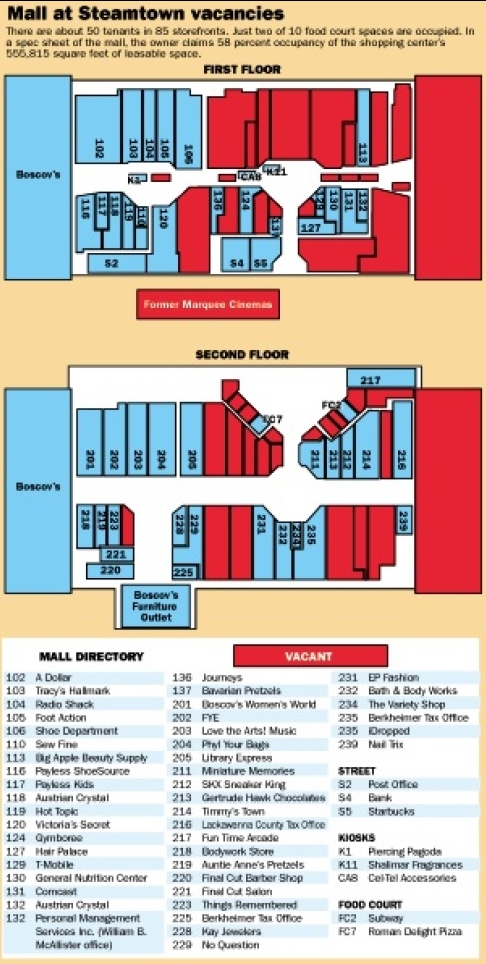 Community leaders look at the Mall at Steamtown and see possibilities in the empty store windows and vacant restaurant counters.
Community leaders look at the Mall at Steamtown and see possibilities in the empty store windows and vacant restaurant counters.
There are about 50 tenants in 85 storefronts, according to a count by BusinessWeekly, and not all are retailers. Just two of 10 food court spaces are open. In a spec sheet of the mall, the owner claims 58 percent occupancy of the shopping center’s 555,815-square-feet of leasable space.
Nationwide, mall occupancy rates were 94.2 percent at the end of 2014, according to the International Council of Shopping Centers.
BusinessWeekly surveyed leaders in the community and found many believe the mall can be something great with the help of some creativity and cooperation.
“I think (the mall) should be repurposed. I’m not quite sure repurposed to what,” said Mayor Bill Courtright. “I don’t think you can dismiss any suggestions.”
Attracting more people to the downtown district and creating jobs would be clear benefits of the change, he said.
“The sooner the better,” he said of repurposing the mall. “I would like that it happened yesterday.”
He acknowledged nothing can happen until someone buys the mall.
The former owner and developer of the mall, Steamtown Mall Partners, defaulted on its debt and the property entered foreclosure in March 2014. LNR Partners took possession after a July sheriff’s sale when no one bid to cover the $37.7 million of bad debt.
Anchor store Bon-Ton closed in early 2014, followed by Express, Abercrombie & Fitch and others.
The mall may have a new owner soon, as LNR scheduled it to go up for auction June 1-3, with bidding to begin at $1 million.
Repurposing
Across the country, lower-tier malls, or those that do not have luxury stores, struggle to make ends meet due to increased competition, online shopping and changing consumer trends. Some are repurposed for varied uses, including educational or medical spaces, religious centers and offices. Others are totally or partially torn down to make space for outdoor town centers, which include residential space, shops, restaurants and outdoor gathering space.
The Granite Run Mall in Delaware County is currently undergoing a $100 million “de-malling” project that will give its area a mixed-use complex slated to include luxury apartments, retail space, restaurants and a movie theater, all in a pedestrian-friendly space along a main road. The plan is expected to include the mall’s anchor stores, Boscov’s and Sears, The Philadelphia Inquirer reported.
Widely recognized as a “dead mall,” Granite Run has just 30 operating stores in 125 retail spaces. The mall’s current owner, BET Investments, is leading the revitalization efforts.
Finding a new use for the mall seemed the only option, BET President Michael P. Markman said.
“In a lot of ways, it decided itself because the internal mall had lost the majority of its tenants when we took over. … There really wasn’t a need for another internal mall,” Mr. Markman said.
The thriving Springfield Mall is less than 10 miles away in one direction, and two recently built shopping centers are the same distance in the opposite direction.
The story is familiar for anyone who has walked through the Mall at Steamtown in recent months. Quiet stores, empty storefronts and unconventional tenants indicate it might be dying, or already dead.
Michele Dempsey, president and founder of DxDempsey Architecture, suggested a plan similar to Granite Run’s to revive the Mall at Steamtown’s footprint as part of her firm’s “What if Scranton” project, which reimagines pieces of Scranton in ways that are modern and pedestrian-friendly. Her suggestion is a lifestyle center including retail space, offices and residencies, while maintaining parking and Boscov’s.
This would eliminate the “dead zone” outside the mall building and make Lackawanna Avenue livelier, Ms. Dempsey said. In Scranton and elsewhere, urban malls have reached the end of their life cycles but were never really a good idea, she added.
“Downtown malls fly in the face of urban planning principles,” she said. The mall “invites people to come in, stay there and leave,” which is not healthy for the city, she added.
Anchor stores and in-line stores, or the stores along the corridors of a mall, depend on each other in a circular relationship, according to the 2015 U.S. Mall Outlook report produced by Green Street Advisors, a real estate research and advisory firm.
In addition to the dependent relationship between anchor stores and smaller retailers, a mall’s foot traffic and the success of its stores are also closely related. Competition and shifting demographics can cause malls to have fewer shoppers, which forces stores to close, in turn attracting even fewer visitors, Green Street Advisors found.
“This vicious cycle will continue until the mall becomes obsolete,” according to the report.
Not everyone thinks the death of the mall is inevitable, though.
Boscov hopeful
Al Boscov said he is waiting to hear whether Boscov’s Department Stores will be able to regain ownership of the mall, which it lost in foreclosure in 2014.
“We’re hoping to get possession of it,” said the company’s chairman about the mall. “It’s not in our hands.”
He also said Boscov’s stores, including the one at Steamtown, are doing well, so he thinks the department store can help the mall stay in business. On Friday, he announced he stepped down as CEO earlier this year and his nephew, Jim Boscov, took the reins.
“We’re hoping to bring the mall back to life,” Al Boscov said in an interview before Friday’s announcement. “We have the opportunity to since we are still alive and doing well.”
Mr. Boscov also said many stores shut their doors after Bon-Ton closed because their leases allowed them to leave if the mall was left with only one anchor store. Mr. Boscov claims if mall purchasers want to make the mall into anything other than a traditional indoor retail mall, Boscov’s will have to approve it.
The Mall at Steamtown opened in 1993 after about a decade of plans and setbacks. Originally, there were 65 retailers and three anchors: Boscov’s, the Globe Store and Montgomery Ward. Mr. Boscov previously had partial ownership in the mall with Steamtown Mall Partners, which defaulted on a $37.1 million mortgage payment in July 2013.
The current on-site mall manager, Clarence Banks, declined to comment for this story, referring questions to Zamias Inc., a property management and development firm. Zamias and LNR Partners also declined to comment.
Some malls are “dying” because they failed to evolve as customers’ tastes and habits shifted, one expert said.
“Malls have hurt themselves by not changing, by not engaging consumers,” said Richard Feinberg, Ph.D., professor of consumer sciences and retailing at Purdue University, who described himself as “a fan of malls.”
Online shopping has also taken some of their business.
“We don’t need (malls) anymore,” he said. “The mall has got to look in the mirror and say, ‘What is it that we need to do to become more compelling in the consumers’ lives?’ and they haven’t done it.”
Contact the writer: Lfay@timesshamrock.com
State Sen. John Blake
“There are solutions that could meet this challenge,” Mr. Blake said, adding that he does not know what should come of the mall or how soon, but he supports a change.
The mall no longer fits the “21st century retail experience” and must “be reset for the market,” he said.
Ideas such as creating a space like the Reading Terminal Market show a sense of creativity that will be essential to any plan, he added. Mr. Blake also mentioned public-private partnerships and cooperation among local, county and state governments should be part of the planning.
“I just know I will be an advocate to get it right,” he said.
Robert F. Durkin, president, Scranton Chamber of Commerce
“Retail is very different now than it was 20 years ago,” Mr. Durkin said, noting that people now frequently use storefronts as showrooms and shop on cellphones and computers. He added that retail success in places such as Commerce Boulevard in Dickson City and the Shoppes at Montage in Moosic also shows that consumers are moving away from indoor malls. Across the country, he said, malls are “not working,” but he attributes the decline to a change in the marketplace rather than any specific party.
Mr. Durkin said he would like to see a mall site that is similar to the rest of the downtown, which he called walkable and appropriately scaled for Scranton, but he is patient. For right now, though, the mall is a private enterprise in the economic marketplace and investors are holding the reins, he said.
“I understand that the community may feel a little impatient about where we’re going to go with this thing, but the complexity of the legal entanglements over there require patience,” Mr. Durkin said.
George Kelly, Lackawanna County’s economic development director
The mall needs to evolve, but that does not necessarily mean demolition, Mr. Kelly said, calling the mall “an important asset” to the area.
“I’d love to see it reinvented into something that would work,” he said.
Mr. Kelly said he does not want to see the mall come down because it is an icon for the area. He would rather find a creative way to revive the mall so it attracts more people. However, Mr. Kelly mentioned projects such as GoggleWorks, the factory in Reading reconfigured into a community arts center, as a potential solution in Scranton. He said he’s open to ideas and solutions.
“I’ll do whatever we can to make the mall a vibrant place.”

JOHN COGNETTI AT THE TIMES-TRIBUNE OUTLOOK ECONOMIC FORUM. MICHAEL J. MULLEN / STAFF PHOTOGRAPHER
John Cognetti, president of Hinerfeld Commercial Real Estate
“I think that the best thing … is to bring the creative minds of Scranton together,” Mr. Cognetti said.
There should be a charette, a meeting of architects and other community leaders, to generate ideas for revamping the mall, Mr. Cognetti said, adding that the mall could thrive as a mixed-use space when it is free from its current legal entanglements.
“It has to be sold to people with vision and the financial wherewithal” to repurpose it, he said.
Looking toward the future and having patience during this period of transition will be keys to that transition, he said.
Boscov’s should stay because it serves a niche market, but Mr. Cognetti imagines the rest of the space being used for meeting and office space as well as educational and medical facilities, he said.
Specifically, Mr. Cognetti said the food court space on the mall’s upper level would be excellent for a meeting or catering space because of the big windows and open layout.





